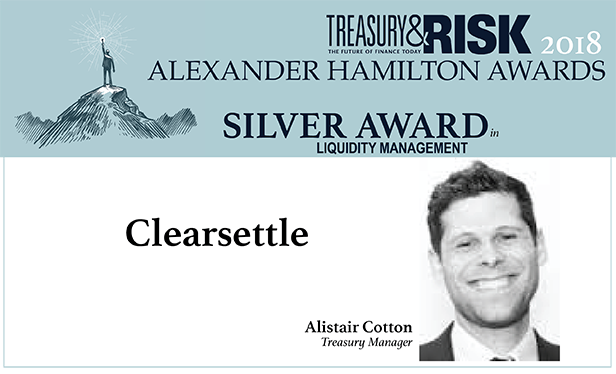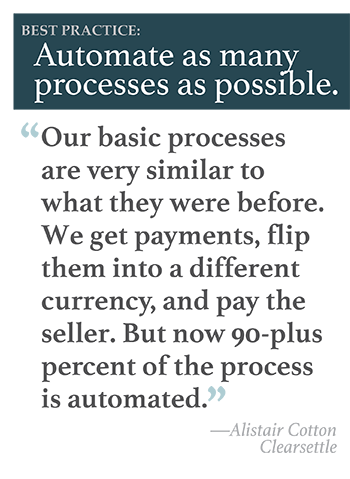
For London-based tech startup Clearsettle, liquidity isn't justimportant to support the business—it is the business. Thecompany provides a technology platform that settles cross-bordertransactions for online merchants.
|Alistair Cotton, treasury manager for Clearsettle, explains hiscompany's service by describing a hypothetical U.K. footwearretailer: “Maybe their shoes suddenly become fashionable in Asia,and lots of Japanese customers start coming to shop on theirwebsite,” he says. “But if the merchant only has a U.K. cardacquirer, Japanese customers' credit cards won't work. WhatClearsettle does is connect to acquirers and other organizationsthat provide payment settlement. So for the merchant, instead ofhaving to do integrations with a lot of different banks around theworld, they do one integration with us and we allow them toglobalize their acceptance of payments on their websites.”
|Once a retailer has integrated with the Clearsettle platform, itcan go to the solution's “payment wall” and select which paymenttypes it will accept, from among more than 50 options. “We make itvery easy for them to put cross-border payment options on theirwebsite and start accepting payments globally rather than having tointegrate a lot of different technologies,” Cotton says. “They canfocus on what they're doing well—selling shoes, in this example—andwe provide the underlying plumbing for them get paid for theirproducts worldwide.”
|Every day, Clearsettle takes on the foreign exchange (FX) riskinherent in tens of thousands of cross-border transactions.“Suppose the Japanese customer wants to pay in yen, while themerchant expects payment in GBP [British pound],” Cotton explains.“The card acquirer in Japan will pull the yen from the customer'scard and settle to us, and we'll flip it into pounds to pay themerchant. The FX risk comes in on the settlement terms and timing.To shield the merchant from currency risk, we will settle to themwhen the payment is made, but the acquirer might not settle to ustill three days after the transaction. In those three days, the FXrate might move significantly one way or the other.”
|As its transaction volume grew and currency risks ballooned,Clearsettle needed better visibility into the balances in its30-plus banking systems. “We built this business quickly, whichrequired us to open accounts with banks all over the world,” Cottonsays. “But to get a view of our cash position in various currenciesevery day, someone had to get all the tokens, log into each bank'sportal, download the statements, then upload the data into ouraccounting system. We needed a tool that could automatically pullall our banking data together and consolidate it in one place.”
|In fact, Cotton and his team set out to automate as manyportions of their liquidity management processes as possible. Theywanted a flexible treasury workstation that could streamlineconnections to all their banks. They chose a treasury managementsystem from TreasuryXpress, which they then customized to meettheir needs.
|Clearsettle worked with TreasuryXpress to connect the system toits different banks via technologies such as applicationprogramming interfaces (APIs), EBICS, and SWIFT messaging. “Onething we learned from this project,” says Cotton, “is that outsidethe United States, there is no standardization in bankconnectivity, and many banks do not have experience automatingtheir connections to customers. Efforts to integrate with bankportals is very, very varied.”
|That said, the resulting system now pulls in data automaticallyfrom all of Clearsettle's banks, giving the company a consolidatedview of cash holdings and currency risk around the world. Thesolution also houses information about all payments that passthrough the Clearsettle platform, maintaining running totals of thecompany's outstanding risk in each currency. When its cash holdingin a particular currency reaches a pre-set threshold, the systemautomatically initiates a trade that takes Clearsettle's FX riskfor that currency back down to zero.
|“Having cash visibility allows us to achieve internal netting ofour cash balances in different currencies while FX transactions aregoing on in the background,” Cotton says. “That's basically moneyin our pocket straightaway.” As an example, Cotton describes arecent situation in which a British customer was using Clearsettleto fund purchase of a property denominated in Norwegian kroner.
| “Our gateway processes a lot ofkroner,” he says. “Before we had this system, we would have boughtNorwegian kroner to fund purchase of the property at the same timethat we were selling kroner into euro to fund other payments. Butbecause we had better visibility into our cash holdings, we sawthat other, smaller transactions settling at the same time wereequivalent to about 80 percent of the value of the propertypurchase. We were able to avoid spending the bid-ask spread onmultiple FX transactions.” Cotton estimates that over the course ofa year, such netting saves the company hundreds of thousands ofpounds.
“Our gateway processes a lot ofkroner,” he says. “Before we had this system, we would have boughtNorwegian kroner to fund purchase of the property at the same timethat we were selling kroner into euro to fund other payments. Butbecause we had better visibility into our cash holdings, we sawthat other, smaller transactions settling at the same time wereequivalent to about 80 percent of the value of the propertypurchase. We were able to avoid spending the bid-ask spread onmultiple FX transactions.” Cotton estimates that over the course ofa year, such netting saves the company hundreds of thousands ofpounds.
The system also automatically routes payments crossing theClearsettle platform for the necessary authorizations, and it booksall transactions and FX trades into Clearsettle's accountingsystem. “Our basic processes are very similar to what they werebefore,” Cotton says. “We get payments, flip them into a differentcurrency, and pay the seller. But now 90-plus percent of theprocess is automated.”
|By eliminating the vast majority of the manual work that itsprior environment required, Clearsettle freed up management formore analysis. This has improved FX decisions and presented newopportunities. “For example, if we think the market for aparticular currency is falling—say, dollars can buy more and morepounds—then we might change the thresholds for FX trades on thosetwo currencies to try to profit from the rate change,” Cotton says.Overall, Clearsettle's FX margins have improved by around $200,000a year.
Complete your profile to continue reading and get FREE access to Treasury & Risk, part of your ALM digital membership.
Your access to unlimited Treasury & Risk content isn’t changing.
Once you are an ALM digital member, you’ll receive:
- Critical Treasury & Risk information including in-depth analysis of treasury and finance best practices, case studies with corporate innovators, informative newsletters, educational webcasts and videos, and resources from industry leaders.
- Exclusive discounts on ALM and Treasury & Risk events.
- Access to other award-winning ALM websites including PropertyCasualty360.com and Law.com.
*May exclude premium content
Already have an account? Sign In
© 2024 ALM Global, LLC, All Rights Reserved. Request academic re-use from www.copyright.com. All other uses, submit a request to [email protected]. For more information visit Asset & Logo Licensing.







